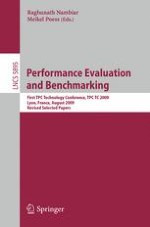First established in August 1988, the Transaction Processing Performance Council (TPC) has shaped the landscape of modern transaction processing and database benchmarks over two decades. Now, the world is in the midst of an extraordinary information explosion led by rapid growth in the use of the Internet and connected devices. Both user-generated data and enterprise data levels continue to grow ex- nentially. With substantial technological breakthroughs, Moore's law will continue for at least a decade, and the data storage capacities and data transfer speeds will continue to increase exponentially. These have challenged industry experts and researchers to develop innovative techniques to evaluate and benchmark both hardware and software technologies. As a result, the TPC held its First Conference on Performance Evaluation and Benchmarking (TPCTC 2009) on August 24 in Lyon, France in conjunction with the 35th International Conference on Very Large Data Bases (VLDB 2009). TPCTC 2009 provided industry experts and researchers with a forum to present and debate novel ideas and methodologies in performance evaluation, measurement and characteri- tion for 2010 and beyond. This book contains the proceedings of this conference, including 16 papers and keynote papers from Michael Stonebraker and Karl Huppler.
